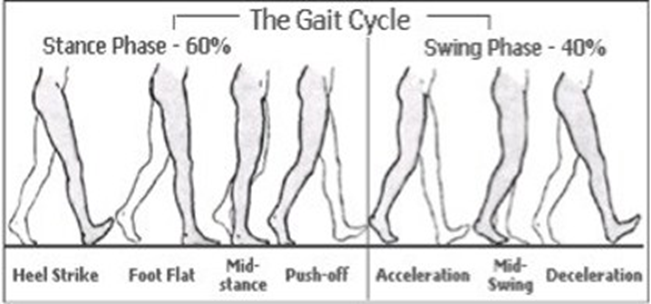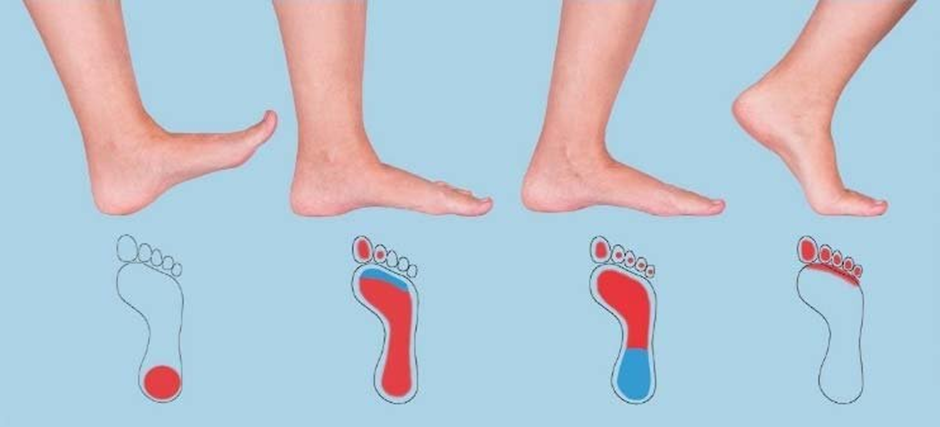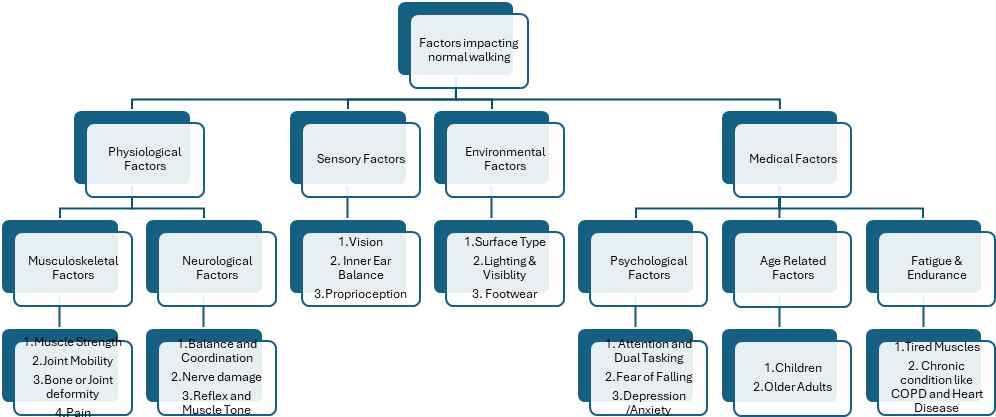All about Normal Walking Gait
How does a normal person walk?
Normal walking also called as Gait cycle is the combination of our leg and body movement during walk. It’s a coordinated motion mainly comprising of Stance Phase 60% and Swing Phase 40%.
Stance phase is when you entire or part of your foot is touching the ground and supporting your body weight. Swing phase is when the foot is in the air for you to take the next step and move forward. What is of prime importance is to understand in detail the stance phase which will help us to alleviate most of the foot related problems.
Let’s understand in little detail the stance phase: This starts with
Heel Strike: Where the Heel touches the ground first.
Foot Flat: Then the entire foot comes in contact with the ground.
Midstance: This is where the load of your body starts to move over your foot and more towards the forefoot.
Heel Off: Then the Heel starts to lift off the ground.
Toe Off: This the phase where the entire body weight gets shifted to the fore foot and toe. Its also called the push off phase where in the toe pushes the feet to move forward.
Swing Phase consist of Initial Swing: the lift off wherein you foot is behind your body.
Mid Swing: The leg moves forward under the body and finally
Terminal Swing: Leg movement decelerates and prepare for landing.

It also is equally important to know the weight distribution of your foot during these phases. In the pic you could see the areas in red are the places of weight load distribution. Apart from this also important is Biomechanics of the foot which looks into the ground reaction force, centre of mass, motion and muscle activity involved in normal walking. This is significant information when it comes to solving most of your foot related issues, which I will come to later.

What factors impact Normal Walking?
There are multiple factors that affect Normal walking from Physiological factors, Sensory factors, psychological factors, environmental factors, medical Conditions…
Let me briefly explain the above

1. Musculoskeletal Factors
Muscle strength: Weakness in core or leg muscles affects stride and balance.
Joint mobility: Stiffness in hips, knees, ankles, or spine limits range of motion.
Bone or joint deformities: Conditions like flat feet, leg length discrepancy, or arthritis alter alignment.
Pain: Pain anywhere in the lower body leads to compensation (limping, shorter steps, etc.).
2. Neurological Factors
Balance and coordination: Controlled by the cerebellum and sensory feedback. Impairments can cause unsteadiness or wide-based gait.
Nerve damage or diseases: Stroke, Parkinson’s, multiple sclerosis, or neuropathy affect motor control, sensation, or timing.
Reflexes and muscle tone: Too much tone (spasticity) or too little (flaccidity) disrupt smooth motion.
3. Sensory Factors
Vision: Needed for spatial awareness, obstacle detection, and pathfinding.
Vestibular function: Inner ear balance system helps maintain upright posture.
Proprioception: Awareness of limb position—crucial for foot placement and adjusting to surfaces.
4. Psychological/Cognitive Factors
Attention and dual-tasking: Walking while distracted (e.g., on the phone) can impair coordination, especially in older adults.
Fear of falling: Can cause cautious, rigid gait (small steps, wide base).
Depression or anxiety: Sometimes linked to slower, less energetic gait.
5. Environmental Factors
Surface type: Slippery, uneven, or inclined surfaces challenge stability.
Lighting and visibility: Poor lighting increases missteps.
Footwear: Ill-fitting shoes or heels can throw off alignment and stride.
6. Age-related Factors
Children: Gait matures with age; toddlers have short steps, wide base.
Older adults: Often show reduced stride length, slower pace, and increased double support time due to muscle loss and balance decline.
7. Fatigue and Endurance
Tired muscles mean decreased force production and slower, less efficient walking.
Chronic conditions (like COPD, heart disease) may cause shortness of breath during walking.


30 thoughts on “All about Normal Walking Gait”
Francis3147
July 26, 2025https://shorturl.fm/OjpdD
Brooks2438
July 26, 2025https://shorturl.fm/umMJj
Willow355
July 28, 2025https://shorturl.fm/bOxc1
Simon2809
August 1, 2025https://shorturl.fm/qLaWu
Barret4019
August 1, 2025https://shorturl.fm/JlODy
Katelyn3940
August 1, 2025https://shorturl.fm/qKodX
Curtis4282
August 1, 2025https://shorturl.fm/K7giP
Jake828
August 2, 2025https://shorturl.fm/tLwRo
Kendall4392
August 2, 2025https://shorturl.fm/xx23r
Ashley2140
August 3, 2025https://shorturl.fm/n0rlP
Betsy1387
August 4, 2025https://shorturl.fm/4iGLh
Briley3010
August 4, 2025https://shorturl.fm/rw7Yf
Maureen3110
August 4, 2025https://shorturl.fm/D4Dfj
Quentin3042
August 4, 2025https://shorturl.fm/xpFjw
Rose2979
August 6, 2025https://shorturl.fm/ECtK1
Don234
August 7, 2025https://shorturl.fm/trr1n
Alan3858
August 8, 2025https://shorturl.fm/yixuA
Dennis254
August 11, 2025https://shorturl.fm/s8zCS
Emery4159
August 12, 2025https://shorturl.fm/Qj12w
Jermaine4815
August 12, 2025https://shorturl.fm/Jr0V7
Aileen102
August 19, 2025https://shorturl.fm/881LP
Stephanie4642
August 19, 2025https://shorturl.fm/JskXv
Erin3120
August 28, 2025https://shorturl.fm/CjWGN
April3831
September 3, 2025https://shorturl.fm/4r8lL
Joyce883
October 3, 2025https://shorturl.fm/7Z2Hn
Evelyn4310
October 7, 2025https://shorturl.fm/PWGfJ
Marcel2888
October 15, 2025https://shorturl.fm/Y2g26
Diego4945
October 16, 2025https://shorturl.fm/gui12
Piper3362
October 21, 2025https://shorturl.fm/PxKMB
Hanna3831
November 21, 2025https://shorturl.fm/OHYdx